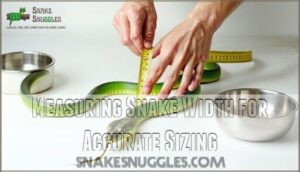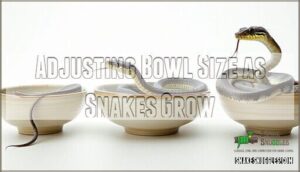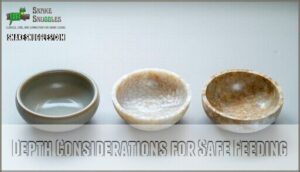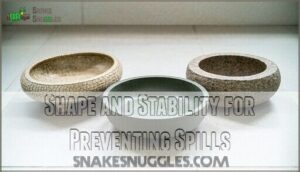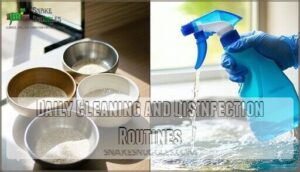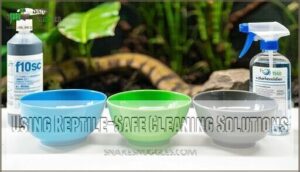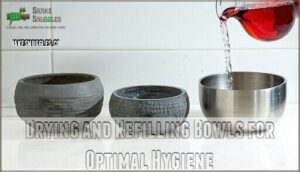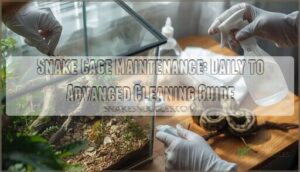This site is supported by our readers. We may earn a commission, at no cost to you, if you purchase through links.
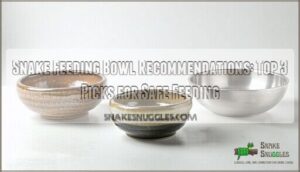
You’ll want a bowl that’s wide enough for your snake to curl up comfortably but shallow enough to prevent drowning—think kiddie pool, not diving board.
Ceramic bowls resist bacterial growth better than plastic, while stainless steel options are virtually indestructible.
Size matters too: your bowl should accommodate your snake’s width plus some wiggle room.
Daily cleaning with hot water keeps things fresh, and weekly disinfection prevents nasty biofilm buildup.
The right bowl becomes your snake’s dining room and occasional spa rolled into one essential piece of equipment.
Table Of Contents
- Key Takeaways
- Snake Feeding Bowl Essentials
- Top 3 Snake Feeding Bowls
- Choosing The Right Bowl Size
- Maintaining Hygiene and Safety
- Frequently Asked Questions (FAQs)
- Should a snakes water bowl be on the hot or cold side?
- Do snakes need a soaking bowl?
- Is it normal for snakes to sit in their water bowl?
- Can snakes share feeding bowls safely?
- How often should feeding bowls be replaced?
- Should feeding bowls differ from water bowls?
- What temperature should feeding bowl water be?
- Do different snake species need specialized bowls?
- Conclusion
Key Takeaways
- Choose ceramic or stainless steel bowls over plastic – they’re non-porous, resist bacterial growth, and won’t harbor dangerous biofilm that can make your snake sick.
- Size your bowl to 1-1.5 times your snake’s width at the thickest point, with 1-2 inches of depth to prevent drowning while allowing comfortable access to food and water.
- Clean daily with hot water and scrub weekly with reptile-safe disinfectants like F10SC to prevent bacterial buildup and maintain your snake’s health.
- Place the bowl on the cool side of your enclosure with a wide, stable base to prevent tipping during feeding and reduce food spoilage from excess heat.
Snake Feeding Bowl Essentials
You’ll want to select the right feeding bowl to keep your snake healthy and prevent messy accidents during feeding time.
The material, size, and placement of your snake’s bowl can make the difference between stress-free meals and frustrating cleanup sessions.
Material Selection for Durability
When choosing snake feeding bowls, you’ll want materials that stand the test of time.
Stainless steel bowls are virtually indestructible and won’t harbor bacteria, while ceramic glazes offer stability and easy cleaning.
Food-grade plastics and plastic composites provide affordable options, though they may scratch over time.
Sealed stone dishes add natural aesthetics but require proper sealing to prevent bacterial growth in porous surfaces.
Some keepers prefer ceramic reptile dishes because they’re easy to clean.
Size and Depth Considerations
Getting the right dish size prevents messy spills and stressed snakes.
Measure your snake’s width at its thickest point, then choose a bowl 1-1.5 times wider.
Depth should stay around 1-2 inches—shallow enough for easy prey access but deep enough to contain food.
Bowl shape matters too; wide, stable bases prevent tipping during feeding sessions, which is crucial for easy prey access and to prevent messy spills.
Preventing Bacterial Growth and Maintenance
Your snake’s health depends on keeping bacteria at bay in feeding bowls.
Material porosity makes plastic bowls bacterial magnets, while stainless steel resists colonization best.
Looking at the content about snake feeding bowls and the specific paragraph about material porosity, here’s an engaging blockquote that matches the tone:
**Choose stainless steel over plastic—bacteria can’t hide where they can’t stick.
Here’s your bacterial growth prevention playbook:
- Daily cleaning frequency – Clean after every feeding and refill to prevent biofilm formation within 24-48 hours
- Safe disinfectants – Use reptile-safe products like F10SC or diluted bleach (1:10 ratio) for weekly sterilization
- Thorough residue removal – Scrub with dedicated brushes and rinse completely to eliminate cleaning agent traces
- Air-dry completely – Skip towels that recontaminate; moisture promotes bacterial growth and biofilm prevention fails
- Replace damaged bowls – Cracks and scratches harbor bacteria regardless of disinfection efforts.
Regular cleaning can also help prevent unwanted bacterial growth.
Placement and Accessibility in Enclosures
Position your snake feeding dish on the cool side of the enclosure to prevent food spoilage and maintain proper temperature gradient.
Choose a low-traffic area away from hiding spots to reduce stress during feeding.
Make certain accessibility by placing the dish on stable substrate, avoiding loose materials that could tip the bowl.
Consider your snake’s size and enclosure layout when determining the best snake water bowl placement for both feeding and drinking needs, and ensure the area is suitable for your pet’s overall well-being, taking into account the importance of a proper feeding environment.
Top 3 Snake Feeding Bowls
Now that you’ve got the basics down, let’s look at three standout feeding bowls that’ll keep your snake happy and healthy.
These picks combine durability, safety, and practical design to make feeding time stress-free for both you and your serpent friend.
1. Reptile Food and Water Bowl
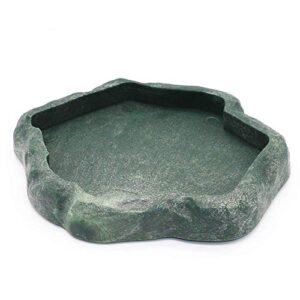
This budget-friendly bowl’s ABS plastic construction won’t break when your snake decides to redecorate. Measuring 4.9" x 5.5" x 0.7", it’s perfect for small to medium reptiles.
The shallow design prevents drowning while allowing easy access to food or water. You’ll love how the flat bottom stays put, and the jungle-green color adds natural appeal.
Easy cleaning means less fuss, more time enjoying your scaly friend. Proper snake hydration is also essential for shedding and overall health, as discussed in the Proper snake hydration guide.
Just rinse and refill, following the principles of easy cleaning and proper hydration to keep your pet healthy.
Best For: Small to medium reptiles like snakes, lizards, and geckos needing a shallow, easy-access food or water bowl that fits compact enclosures.
- Too shallow for crawling insects or for snakes that like to soak
- Not suitable for large snake breeds due to its small size
- Jungle-green style may not match every tank décor
- Durable ABS plastic stands up to active reptiles and won’t break easily
- Shallow, flat-bottomed design prevents tipping and accidental drowning
- Easy to clean—just rinse or wipe and refill
2. Reptile Water and Food Bowl
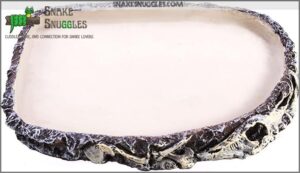
Crafted from high-quality resin with a natural rock-like surface, this water and food bowl blends seamlessly into your snake’s habitat.
The ancient creature bone inlays add a spooky aesthetic that’ll make your terrarium the talk of the reptile community.
At 8.5 x 6.1 x 0.8 inches, it’s perfect for geckos, small snakes, and tortoises.
The smooth surface cleans easily with just water and a brush, though the shallow depth means larger ball pythons might cause spillage during soaking sessions.
Best For: Small reptiles and amphibians like geckos, tortoises, and snakes needing a natural-looking, easy-to-clean water or food bowl.
- Natural rock-like design with unique bone inlays blends seamlessly into enclosures.
- Made from durable, non-toxic resin for safety and long-lasting use.
- Easy to clean thanks to the smooth, non-stick surface.
- Shallow depth may lead to water spillage, especially for soaking ball pythons.
- Not suitable for reptiles requiring deep daily water intake.
- Size may be too large for the smallest juvenile reptiles.
3. Escape Proof Reptile Food Dish
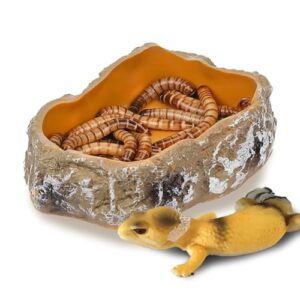
Some feeder insects are true escape artists, turning your terrarium into their personal playground.
The Escape Proof Reptile Food Dish solves this problem with inward-curved walls and raised lips that block climbing insects.
Its smooth ceramic or plastic finish reduces grip, containing crickets, dubia roaches, and worms effectively.
Available in multiple sizes, it’s perfect for hatchlings through adults, doubling as a water bowl when needed.
Best For: Reptile owners who need a dish that reliably contains feeder insects and serves as a versatile food or water bowl for various reptile species.
- Inward-curved walls and smooth finish prevent feeder insect escapes
- Available in multiple sizes to suit hatchlings and adult reptiles
- Doubles as a food or spill-resistant water bowl, easy to clean
- High walls may be too tall for small or juvenile reptiles
- Lighter models less stable for aggressive or large pets
- Athletic insects may still occasionally escape
Choosing The Right Bowl Size
You’ll want to measure your snake’s width at its thickest point to select the perfect bowl size.
Getting the dimensions right prevents feeding stress and guarantees your snake can comfortably access its meals without struggle, ensuring a smooth and healthy eating experience with minimal struggle.
Measuring Snake Width for Accurate Sizing
You’ll need to measure your snake’s width at the thickest measuring point, typically the midsection, for proper snake feeding bowl sizing.
This measurement guarantees comfortable access and stress reduction during feeding, while accounting for species variation across different growth stages.
Key measurement techniques include:
- Flexible tape method: Use soft measuring tape around the snake’s widest body section for accurate dish size determination
- Comparison approach: Match your snake feeding dish size directly to the snake’s thickest part using visual reference
- String measurement: Wrap string around the snake width, then measure against a ruler for precise bowl size selection
Your snake feeding bowl should be 1-1.5 times the measured snake width to prevent overfeeding while allowing easy prey access.
Selecting a bowl also means considering appropriate dish materials like ceramic or stainless steel for safety.
Adjusting Bowl Size as Snakes Grow
After measuring your snake’s width, you’ll need to upgrade bowl sizes as your pet grows.
Start with a 4-6 inch dish for hatchlings, move to 6-8 inches for juveniles, and choose 9-10+ inch bowls for adults.
Giant breeds may need custom-sized dishes.
Monitor your snake’s growth and adjust accordingly.
| Snake Stage | Bowl Size | Width Guidelines |
|---|---|---|
| Hatchling | 4-6 inches | 1-1.5x snake width |
| Juvenile | 6-8 inches | Matches body growth |
| Adult | 9-10+ inches | Accommodates full size |
| Giant Breed | 12+ inches | Custom sizing needed |
| Molting Period | Same size | May need deeper dish |
The table provides a clear guideline for choosing the right bowl size based on your snake’s growth stage.
It’s essential to consider the snake’s width when selecting a bowl to ensure comfort and safety.
Depth Considerations for Safe Feeding
Bowl depth directly impacts your snake’s feeding safety and comfort.
For drowning prevention, keep depths at 1-2 inches for most species. Hatchling depths should stay around 1 inch, while adult depths can reach 2 inches safely.
Proper dish depth guarantees easy prey access without safety risks. Your snake’s size determines preferred feeding bowl recommendations for secure, stress-free meals.
Shape and Stability for Preventing Spills
You’ll want a bowl that won’t budge when your snake gets curious.
Look for wide-based designs with low centers of gravity – they’re your best defense against snake water bowl stability issues.
Heavy materials like ceramic or thick plastic provide natural tipping prevention through material weight.
Bowl shape matters too: wider bases beat tall, narrow designs every time.
When snakes explore their space, spill resistance becomes your friend, keeping both snake and enclosure clean.
Maintaining Hygiene and Safety
You’ll want to keep your snake’s feeding bowl spotless to prevent dangerous bacteria that can make your pet sick.
Clean bowls daily and watch for that telltale slime buildup that signals it’s time for a deeper scrub.
Daily Cleaning and Disinfection Routines
Once you’ve selected the perfect bowl size, keeping it clean becomes your next priority. Proper water bowl cleaning prevents bacterial growth and guarantees your snake’s health.
Here’s your daily routine disinfection checklist:
- Rinse with hot water to remove food debris and waste
- Scrub with mild dish soap using a dedicated reptile brush
- Apply reptile-safe disinfectant for thorough biofilm prevention
- Rinse completely to confirm proper residue removal
- Air dry before refilling with fresh water
Cleaning frequency matters more than you might think. Daily maintenance keeps your snake healthy and your conscience clear.
Monitoring for Signs of Slime or Biofilm
Regular visual inspection of snake water bowls helps you catch bacterial growth early.
Look for slimy films, cloudy water, or unusual odors that signal biofilm formation.
Check your snake feeding bowls daily, especially after feeding sessions.
Slime prevention starts with consistent water bowl maintenance and proper cleaning frequency to maintain high water quality.
To prevent this, replace substrate regularly as part of deep cleaning to ensure proper cleaning and maintain a healthy environment.
Using Reptile-Safe Cleaning Solutions
When biofilm appears, you’ll need safe disinfectants for snake feeding bowls.
F10SC Veterinary Disinfectant (1:250 dilution) and chlorhexidine-based cleaners like Nolvasan effectively eliminate bacteria without harmful residues.
White vinegar works for routine cleaning, while hydrogen peroxide tackles stubborn organisms.
Always rinse thoroughly after disinfectant use—residue removal protects reptile-safe environments.
Solution effectiveness depends on proper dilution and contact time for ideal cleaning frequency.
You can easily purchase F10SC online for convenience.
Drying and Refilling Bowls for Optimal Hygiene
After proper cleaning with reptile-safe solutions, air drying becomes your next step for maintaining water bowl hygiene. Complete residue removal and thorough drying prevent bacterial growth between cleanings.
Here’s your post-cleaning routine:
- Air Drying Protocol – Let bowls air dry completely before refilling, as trapped moisture creates breeding grounds for bacteria
- Water Quality Standards – Use dechlorinated water and maintain daily refill frequency for ideal snake water bowl hygiene
- Bacteria Prevention Maintenance – Monitor for slime buildup between cleanings, adjusting your changing water frequency based on usage patterns
Frequently Asked Questions (FAQs)
Should a snakes water bowl be on the hot or cold side?
You should place your snake’s water bowl on the cool side of the enclosure.
This prevents excessive evaporation and helps maintain proper humidity levels while ensuring your snake has consistent access to fresh water.
Do snakes need a soaking bowl?
Like a desert oasis beckoning to weary travelers, you don’t need a separate soaking bowl—your snake’s regular water bowl serves this purpose perfectly.
Choose one large enough for comfortable soaking during shedding cycles.
Is it normal for snakes to sit in their water bowl?
Yes, it’s completely normal for snakes to sit in their water bowls.
They often do this to regulate body temperature, increase humidity exposure, or prepare for shedding.
It’s natural behavior, not a health concern.
Can snakes share feeding bowls safely?
Sharing feeding bowls between snakes isn’t safe.
You’ll risk cross-contamination of parasites, bacteria, and diseases between your animals.
Each snake needs its own dedicated feeding dish to prevent health issues and maintain proper hygiene standards.
How often should feeding bowls be replaced?
Like a well-worn favorite dish that’s served its purpose, feeding bowls don’t need frequent replacement unless they’re damaged, cracked, or harbor persistent odors. With proper cleaning, quality bowls last years.
Should feeding bowls differ from water bowls?
Yes, you’ll want separate bowls for feeding and water.
Feeding bowls should be 1-5 times your snake’s width and made from ceramic, glass, or stainless steel for easy cleaning after messy meals.
What temperature should feeding bowl water be?
Room temperature water, around 70-75°F, works best for feeding bowls.
You don’t need to heat it like a spa day!
Cold water can slow digestion, while hot water might stress your snake.
Think Goldilocks – not too hot, not too cold, just right for comfortable feeding.
Do different snake species need specialized bowls?
Most snakes don’t need specialized bowls, but you’ll want to take into account species-specific needs.
Ball pythons benefit from larger soaking bowls, while arboreal species need elevated placement for easy access.
Conclusion
Surprisingly, your snake’s feeding bowl choice affects more than just mealtime—it impacts their overall health and enclosure cleanliness.
The right snake feeding bowl recommendations center on ceramic or stainless steel materials that resist bacterial growth while providing stability during feeding.
Remember, your snake will likely use this bowl for both drinking and occasional soaking, so choose wisely.
A properly sized, easy-to-clean bowl prevents stress during feeding and reduces maintenance headaches.
These simple guidelines guarantee your serpent stays healthy and hydrated year-round.
- https://www.nomoy-pet.com/news/the-ultimate-guide-to-reptile-bowls-choosing-the-best-for-your-scaly-friends/
- https://exo-terra.com/products/hydration/water-dishes/snake-bowl/
- https://amccorona.com/wp-content/uploads/2020/05/ARAV_trifold_ball_pythonv2_2.pdf
- https://community.morphmarket.com/t/best-water-bowls-for-hatchling-rack/18258
- https://www.snakemuseum.com/169-reptile-bowls-dishes

